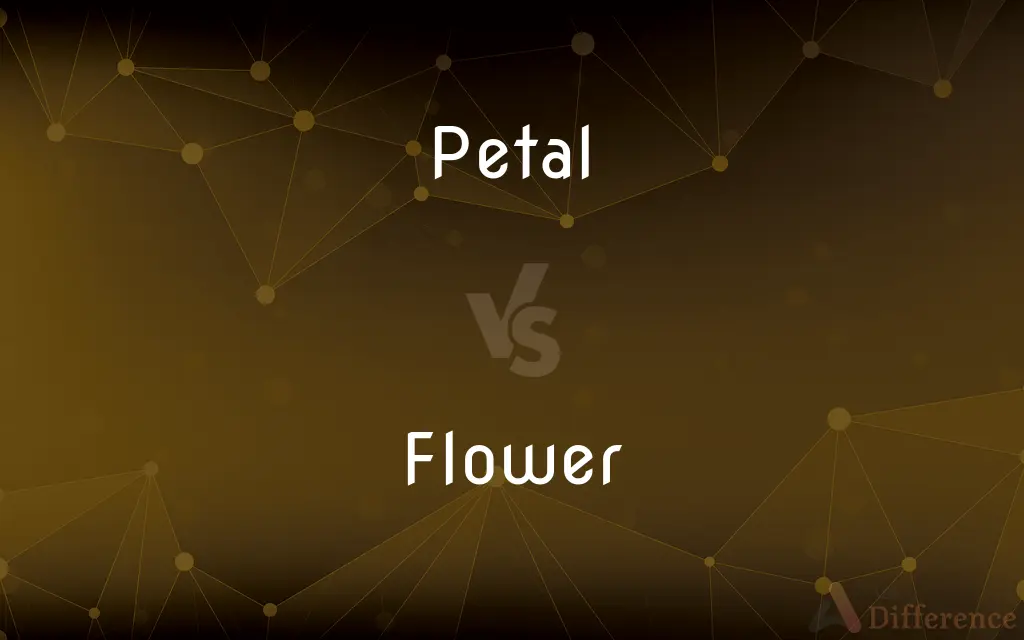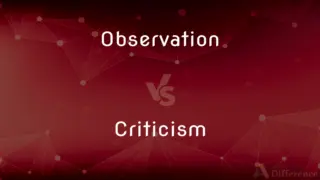Petal vs. Flower — What's the Difference?
By Maham Liaqat & Urooj Arif — Updated on April 15, 2024
A petal is a single component of a flower, typically colorful and involved in attracting pollinators, whereas a flower represents the complete reproductive structure of flowering plants.

Difference Between Petal and Flower
Table of Contents
ADVERTISEMENT
Key Differences
Petals are individual segments of the flower, often vividly colored to attract pollinators such as bees and butterflies. In contrast, the flower encompasses not only the petals but also other parts like sepals, stamens, and the pistil, which contribute to reproduction.
In botanical terms, a petal is one unit of the corolla, the collective term for all the petals of a flower, which is primarily involved in the visual appeal. On the other hand, the flower itself serves the biological function of facilitating reproduction through the mechanisms of pollination and fertilization.
Petals can vary widely in color, size, and shape, each adapted to the specific needs of the plant's pollinators. Flowers, however, coordinate these adaptations into a complete system that includes not just the attractive petals but also the nectaries and reproductive organs.
Some plants, like lilies, have large and colorful petals that play a significant role in the plant’s interaction with its environment. Whereas the entire flower structure, including its stem, roots, and leaves, contributes to the plant’s overall survival and reproduction strategy.
In cultivation, gardeners might select plants based on the characteristics of the petals for aesthetic purposes. In contrast, agricultural practices might focus on the entire flower’s ability to produce fruits and seeds, which are crucial for crop production.
ADVERTISEMENT
Comparison Chart
Definition
Part of the flower; usually colorful
The reproductive structure of flowering plants
Function
Attract pollinators
Facilitate reproduction through pollination and fertilization
Components
Is a component of a flower
Includes petals, sepals, stamens, and pistil
Variability
Varies in size, shape, and color
Consistent structure but varies in size and form across species
Agricultural role
Used primarily for aesthetic selection
Focused on for reproduction and yield of seeds and fruits
Compare with Definitions
Petal
Often soft and delicate.
The petals of the daisy fluttered in the breeze.
Flower
The reproductive part of a flowering plant.
The flower turned into a fruit after pollination.
Petal
Plays a role in reproduction by attracting pollinators.
The bright petals are crucial for attracting bees.
Flower
Can be monoecious or dioecious.
Some flowers contain both male and female parts, others have only one.
Petal
May have different textures.
Some petals are smooth, others are hairy to deter pests.
Flower
Consists of several structures including petals.
Every part of the flower has a role in plant reproduction.
Petal
Can be of various shapes.
The orchid's petals are uniquely shaped to attract insects.
Flower
Essential for the plant's lifecycle.
Without flowers, many plants cannot produce seeds.
Petal
One of the colorful parts of a flower.
The rose had velvety red petals.
Flower
Varies greatly across species.
Flowers can range from simple daisies to complex orchids.
Petal
Petals are modified leaves that surround the reproductive parts of flowers. They are often brightly colored or unusually shaped to attract pollinators.
Flower
A flower, sometimes known as a bloom or blossom, is the reproductive structure found in flowering plants (plants of the division Magnoliophyta, also called angiosperms). The biological function of a flower is to facilitate reproduction, usually by providing a mechanism for the union of sperm with eggs.
Petal
One of the often brightly colored parts of a flower immediately surrounding the reproductive organs; a division of the corolla.
Flower
The reproductive structure of angiosperms, characteristically having either specialized male or female organs or both male and female organs, such as stamens and a pistil, enclosed in an outer envelope of petals and sepals.
Petal
(botany) One of the component parts of the corolla of a flower. It applies particularly, but not necessarily only, when the corolla consists of separate parts, that is when the petals are not connately fused. Petals are often brightly colored.
Flower
Such a structure having showy or colorful parts; a blossom.
Petal
Term of endearment.
Flower
A flower head.
Petal
A lobe of a rose (geometric shape). Category:en:Curves
Flower
A plant that is cultivated or appreciated for its blossoms.
Petal
To spread out from, like the petals of a flower
Flower
The condition or a time of having developed flowers
The azaleas were in full flower.
Petal
One of the leaves of the corolla, or the colored leaves of a flower. See Corolla, and Illust. of Flower.
Flower
The period of highest development or greatest vigor. ]
Petal
One of the expanded ambulacra which form a rosette on the black of certain Echini.
Flower
(botany) A reproductive structure in angiosperms (flowering plants), often conspicuously colourful and typically including sepals, petals, and either or both stamens and/or a pistil.
Petal
Part of the perianth that is usually brightly colored
Flower
A plant that bears flowers, especially a plant that is small and lacks wood.
We transplanted the flowers to a larger pot.
Flower
A cut flower; the stem of a flowering plant with the blossom or blossoms attached, used for decoration, as a gift, etc.
He always keeps a vase full of flowers in his office.
Flower
(usually with in) Of plants, a state of bearing blooms.
The dogwoods are in flower this week.
Flower
The vulva, especially the labia majora.
Flower
The best examples or representatives of a group.
Flower
The best state of things; the prime.
She was in the flower of her life.
Flower
(obsolete) Flour.
Flower
A substance in the form of a powder, especially when condensed from sublimation.
The flowers of sulphur
Flower
A figure of speech; an ornament of style.
Flower
(printing) Ornamental type used chiefly for borders around pages, cards, etc.
Flower
Menstrual discharges.
Flower
A delicate, fragile, or oversensitive person.
Flower
(rare) Something that flows, such as a river.
Flower
To put forth blooms.
This plant flowers in June.
Flower
To decorate with pictures of flowers.
Flower
To reach a state of full development or achievement.
Flower
To froth; to ferment gently, as new beer.
Flower
To come off as flowers by sublimation.
Flower
In the popular sense, the bloom or blossom of a plant; the showy portion, usually of a different color, shape, and texture from the foliage.
Flower
The fairest, freshest, and choicest part of anything; as, the flower of an army, or of a family; the state or time of freshness and bloom; as, the flower of life, that is, youth.
The choice and flower of all things profitable the Psalms do more briefly contain.
The flower of the chivalry of all Spain.
A simple maiden in her flowerIs worth a hundred coats of arms.
Flower
Grain pulverized; meal; flour.
The flowers of grains, mixed with water, will make a sort of glue.
Flower
A substance in the form of a powder, especially when condensed from sublimation; as, the flowers of sulphur.
Flower
A figure of speech; an ornament of style.
Flower
Ornamental type used chiefly for borders around pages, cards, etc.
Flower
Menstrual discharges.
Flower
To blossom; to bloom; to expand the petals, as a plant; to produce flowers; as, this plant flowers in June.
Flower
To come into the finest or fairest condition.
Their lusty and flowering age.
When flowered my youthful spring.
Flower
To froth; to ferment gently, as new beer.
That beer did flower a little.
Flower
To come off as flowers by sublimation.
Observations which have flowered off.
Flower
To embellish with flowers; to adorn with imitated flowers; as, flowered silk.
Flower
A plant cultivated for its blooms or blossoms
Flower
Reproductive organ of angiosperm plants especially one having showy or colorful parts
Flower
The period of greatest prosperity or productivity
Flower
Produce or yield flowers;
The cherry tree bloomed
Common Curiosities
Why are petals colorful?
Petals are often colorful to attract pollinators, which is crucial for the process of pollination.
What distinguishes a petal from a flower?
A petal is a part of the flower, specifically one of the segments of the corolla, usually colorful and attractive, whereas a flower includes all reproductive structures.
How do the number of petals affect a flower's pollination?
The number of petals can influence the flower's attractiveness to pollinators, thereby affecting its pollination success.
Can the shape of petals influence a flower's health?
Yes, the shape and structure of petals can affect how effectively a flower attracts pollinators and therefore its reproductive success.
What is the role of a flower in a plant’s life?
The flower’s primary role is in reproduction, facilitating the process of pollination and seed production.
Do all flowers have the same type of petals?
No, petal shape, size, and color can vary significantly between different species of flowers.
What is the significance of flowers in cultural contexts?
Flowers have significant cultural, symbolic, and aesthetic value in many societies.
Can a flower exist without petals?
Yes, some flowers, like those of many wind-pollinated plants, do not have petals.
What happens to the petals after pollination?
After pollination, petals usually wither and fall off as the flower begins to develop seeds.
Are all parts of a flower equally important?
While all parts contribute to the flower's functions, the reproductive parts like stamens and pistils are critical for reproduction.
Why do some plants have flowers with no petals?
Some plants, particularly those that do not rely on animals for pollination, may have reduced or absent petals.
What determines the color of petals?
Petal color is determined by genetic factors and can be influenced by environmental conditions.
How do flowers adapt to their environments?
Flowers adapt through variations in size, shape, and color, responding to the specific pollinators and climatic conditions of their environments.
How does the presence of flowers affect an ecosystem?
Flowers support biodiversity by providing nectar and pollen to a variety of pollinators.
Are petals used in any products?
Yes, petals are often used in perfumes, teas, and culinary dishes for flavor or decoration.
Share Your Discovery

Previous Comparison
Alphanumeric vs. Alphabetic
Next Comparison
Observation vs. CriticismAuthor Spotlight
Written by
Maham LiaqatCo-written by
Urooj ArifUrooj is a skilled content writer at Ask Difference, known for her exceptional ability to simplify complex topics into engaging and informative content. With a passion for research and a flair for clear, concise writing, she consistently delivers articles that resonate with our diverse audience.
















































